Brian Clark | |
|---|---|
| Born | July 4, 1947 |
| Nationality | Canadian |
| Alma mater | University of Toronto, B.Ap.Sc., industrial engineering, M.B.A. (1971), Thornhill Secondary School (1965) |
| Occupation | Businessman |
| Years active | 1973–2006 |
| Employer | Euro Brokers |
| Known for | Survivor of the September 11 attacks |
Brian Clark (born July 4, 1947) is a Canadian businessman and survivor of the attacks on the World Trade Center on September 11, 2001. Clark worked for the American international brokerage firm Euro Brokers Inc. (later merged into BGC Partners), which lost 61 employees that day, nearly one-fifth of its New York branch. [1]
Clark was one of only 18 people in the South Tower to escape from within or above the impact zone where the plane struck, escaping from his office on floor 84. Clark's testimony before the 9/11 Commission, where he detailed problems with the 911 emergency call system, has been widely quoted. [2] [3] [4] [5] [6]
After Flight 175 struck the South Tower between floors 77 and 85, Clark and eight other employees of his floor who had survived the impact gathered together and started to descend Stairwell A. They only made it to the 81st floor when Clark and his group were met by a woman and a man coming up the stairs. The woman blocked their paths and warned them there were flames and smoke further down, and their only option was to try and go up to the roof in hope of being rescued from there.
Clark and his coworkers stopped and debated on the stairwell landing about what to do next; whether to listen to the woman and go up the stairs or to ignore her warnings and go down the stairs. As the group stood there debating their next move, a faint scream for help coming from inside the 81st floor caught Clark's attention. While his group continued to debate what to do, Clark grabbed coworker Ron DiFrancesco and entered the 81st floor to look for the person screaming for help. As Clark and DiFrancesco entered the floor, Clark turned around to observe his coworkers as they started to go up the stairs to the roof instead of down. That group would all lose their lives that day, as access doors to the roof were locked, and there were no plans for helicopter rescues from the roof, as the NYPD deemed it too unsafe to attempt due to dense clouds of smoke and rooftop antennas. [7] [8]
As Clark and DiFrancesco made their way to the voice screaming for help, DiFrancesco became overcome with smoke and returned to the stairs, which he would also ascend. Unlike the rest of his coworkers who went up the stairs, however, DiFrancesco reversed course and survived. Clark made his way to find Fuji Bank employee Stanley Praimnath, who was pinned underneath some debris behind a wall that had stood firm.
Praimnath had initially evacuated the building after the first plane had hit the North Tower but went back inside as South Tower security gave clearance to reenter the building. Once he had arrived back at his office on the 81st floor, he was on the phone when he noticed the second plane coming right at him. He screamed and jumped under his desk as the plane was hitting the building. After the impact, Praimnath found himself alive under his desk with only minor injuries; the left wing of United Airlines Flight 175 had sliced through his office and become lodged in a door only 20 feet (6 m) from him. [9] When Clark found Praimnath, there was a wall standing between the two, and the only way for Praimnath to escape was to jump up and go over the wall.
Praimnath was unsure he would be able to get over the wall but tried due to Clark's urging. Praimnath made several unsuccessful attempts to climb the wall, on one occasion injuring his hand, but he persisted, and on another attempt Clark was able to hook his arms around Praimnath and help pull him to the other side. [10] [11] [12] [13] [14]
Clark and Praimnath's descent through the floors of the impact was impeded by some debris and smoke, but by moving the debris, they made it passable. [10]
The phones were working in Oppenheimer's offices on the 31st floor. Clark was on the telephone for over three minutes and talked to three different people before his 911 call was understood. This call might have been the only chance for rescue workers to learn that there was a clear stairwell that the several hundred people trapped above the impact could try to use to escape. Clark described how he and Praimnath did not feel a sense of urgency, and before calling 911 they each made one brief personal call. [15]
At 9:55 am, they got to the ground floor where there were rescue workers. One advised them to run once they exited onto Liberty Street, at the southeast corner of the complex. At 9:56 am, Clark and Praimnath ran out of the World Trade Center complex. Clark described how, when they had gotten about two blocks away, Praimnath told him he thought the buildings were going to go down. Clark was skeptical, repeating how solidly built the towers were, but he did not finish his sentence before the South Tower (Tower Two) started to collapse. Clark and Praimnath had left the South Tower just three minutes before it collapsed; they were two of the last 25 people to exit the building; Clark was number 22. Only two other people exited the South Tower after Clark and Praimnath. [16]
Praimnath thanked Clark for saving his life. [10] Clark, in turn, also thanked Praimnath since he felt that the act of leaving his group and freeing Praimnath drew him out of a debate that might have ended with his joining the others who went up to their deaths. His Euro Brokers colleague, Ron DiFrancesco, who had initially turned around because of the smoke, mustered the strength to resume the descent and was the last person to escape the South Tower before its collapse; he awoke several days later in a hospital, suffering from extensive burns and a head laceration. [17] [18]
Sixty-one of Clark's co-workers were killed in the attack. Clark was later appointed by his company's management to be President of the Euro Brokers Relief Fund, created to help take financial care of the families of those who were lost. He retired in 2006, a year after Euro Brokers merged with another company. [18] Since his retirement, he has been volunteering with various non-profit organisations, including serving on the board and as treasurer of the New Brunswick Theological Seminary in New Jersey. [19]

The CN Tower is a 553.3 m-high (1,815.3 ft) concrete communications and observation tower in Toronto, Ontario, Canada. Completed in 1976, it is located in downtown Toronto, built on the former Railway Lands. Its name "CN" referred to Canadian National, the railway company that built the tower. Following the railway's decision to divest non-core freight railway assets prior to the company's privatization in 1995, it transferred the tower to the Canada Lands Company, a federal Crown corporation responsible for the government's real estate portfolio.
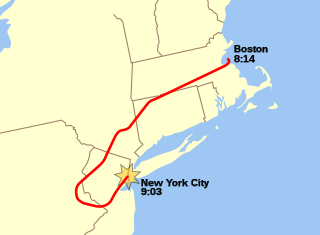
United Airlines Flight 175 was a domestic passenger flight from Logan International Airport in Boston to Los Angeles International Airport in California that was hijacked by five al-Qaeda terrorists on the morning of September 11, 2001, as part of the September 11 attacks. The aircraft involved, a Boeing 767-200 carrying 65 passengers and crew, was deliberately crashed into the South Tower of the World Trade Center in New York City, killing everyone aboard and causing the deaths of more than 600 people in the South Tower's upper levels in addition to an unknown number of civilians and emergency personnel on floors beneath the impact zone. Flight 175's hijacking not only led to it being the second-deadliest of the four suicide attacks carried out on the day in terms of plane and ground fatalities, but also secured its place as second-deadliest plane crash in aviation history, surpassed only by American Airlines Flight 11.
The September 11 attacks of 2001, in addition to being a unique act of terrorism, constituted a media event on a scale not seen since the advent of civilian global satellite links. Instant worldwide reaction and debate were made possible by round-the-clock television news organizations and by the internet. As a result, most of the events listed below were known by a large portion of the world's population as they occurred.

Stairs are a structure designed to bridge a large vertical distance between lower and higher levels by dividing it into smaller vertical distances. This is achieved as a diagonal series of horizontal platforms called steps which enable passage to the other level by stepping from one to another step in turn. Steps are very typically rectangular. Stairs may be straight, round, or may consist of two or more straight pieces connected at angles.
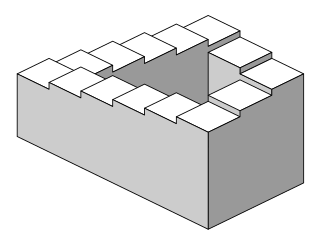
The Penrose stairs or Penrose steps, also dubbed the impossible staircase, is an impossible object created by Oscar Reutersvärd in 1937 and later independently discovered and made popular by Lionel Penrose and his son Roger Penrose. A variation on the Penrose triangle, it is a two-dimensional depiction of a staircase in which the stairs make four 90-degree turns as they ascend or descend yet form a continuous loop, so that a person could climb them forever and never get any higher. This is clearly impossible in three-dimensional Euclidean geometry but possible in some non-Euclidean geometry like in nil geometry.

On Monday, December 1, 1958, a fire broke out at Our Lady of the Angels School in Chicago, Illinois, shortly before classes were to be dismissed for the day. The fire originated in the basement near the foot of a stairway. The elementary school was operated by the Archdiocese of Chicago and had an enrollment of approximately 1600 students. A total of 92 pupils and 3 nuns ultimately died when smoke, heat, fire, and toxic gases cut off their normal means of egress through corridors and stairways. Many more were injured when they jumped from second-floor windows which, because the building had a raised basement, were nearly as high above ground as a third floor would be on level ground.

The World Trade Center in New York City collapsed on September 11, 2001, as result of the al-Qaeda attacks. Two commercial airliners hijacked by al-Qaeda terrorists were deliberately flown into the Twin Towers of the complex, resulting in a total progressive collapse that killed almost 3,000 people. It is the deadliest and most costly building collapse in history.
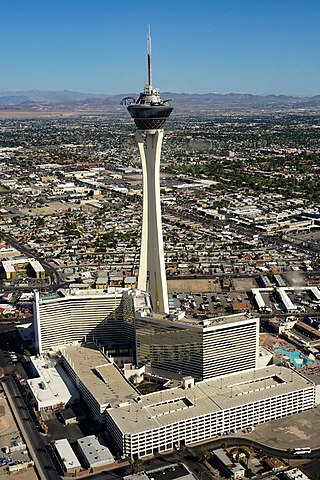
The Strat Hotel & Casino & Tower is a hotel and casino located in Las Vegas, Nevada, United States. It includes a 1,149 ft (350.2 m) observation tower, the tallest in the United States. It is also the second-tallest observation tower in the Western Hemisphere, surpassed only by the CN Tower in Toronto, Ontario. The tower is topped by a skypod which includes a revolving restaurant, lounges, and observation decks. The top of the tower also has several thrill rides. The hotel and casino facilities are situated at the base of the tower, and the resort also includes a showroom and a shopping mall. The Stratosphere is located within city limits on Las Vegas Boulevard, just north of the Las Vegas Strip. The resort is sometimes considered to be a Strip property, although Clark County does not officially recognize it as such, stating that the Strip does not extend into city limits.
Stanley Praimnath is a survivor of the attacks on the World Trade Center on September 11, 2001. He worked as an executive for Fuji Bank on the 81st floor of the South Tower, the second tower struck that day. He was one of only 18 survivors from within or above the impact zone of United Airlines Flight 175.

The Falling Man is a photograph taken by Associated Press photographer Richard Drew of a man falling from the World Trade Center during the September 11 attacks in New York City. The unidentified man in the image was trapped on the upper floors of the North Tower, and it is unclear whether he fell while searching for safety or he jumped to escape the fire and smoke. The photograph was taken at 9:41:15 A.M.
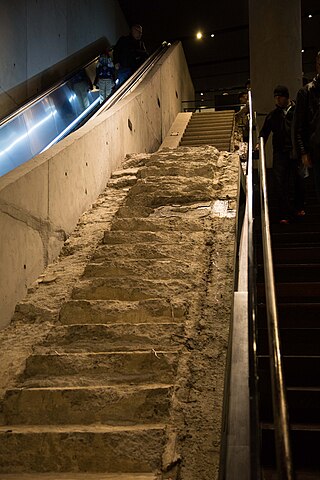
The Survivors' Staircase was the last visible remaining original structure above ground level at the World Trade Center site. It was originally an outdoor flight of granite-clad stairs and two escalators which connected Vesey Street to the World Trade Center's Austin J. Tobin Plaza. During the September 11 attacks, the stairs served as an escape route for hundreds of evacuees from 5 World Trade Center, a 9-floor building adjacent to the Twin Towers. The staircase is now an important feature of the National September 11 Memorial & Museum.

The Field Building, also known as the LaSalle National Bank Building and Bank of America Building is an art deco office building at 135 South LaSalle Street in the Loop community area of Chicago, Illinois in the United States. The building was designated a Chicago Landmark February 9, 1994.

Marsh & McLennan Companies, Inc., doing business as Marsh McLennan, is a global professional services firm, headquartered in New York City with businesses in insurance brokerage, risk management, reinsurance services, talent management, investment advisory, and management consulting. Its four main operating companies are Marsh, Guy Carpenter, Mercer, and Oliver Wyman.
9/11: The Twin Towers is a movie based on the 9/11 attacks which uses re-enactments and computer-generated imagery to re-create a minute-by-minute account of what happened inside the Twin Towers of the World Trade Center in New York City during the September 11 attacks. In the United States it premiered on the Discovery Channel on 3 September 2006, narrated by Harry Pritchett. In the United Kingdom it premiered on BBC One on 7 September 2006, narrated by Terence Stamp.

One Meridian Plaza, formerly known as the Fidelity Mutual Life Building, Three Girard Plaza and Three Mellon Bank Center, was a 38-story high-rise office building in Philadelphia, Pennsylvania, United States. The 492-foot (150-meter) tower was designed by Vincent Kling & Associates and completed in 1972.
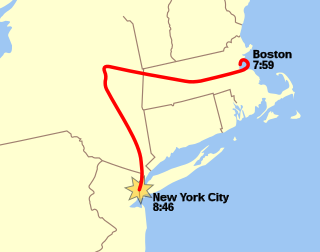
American Airlines Flight 11 was a domestic passenger flight that was hijacked by five al-Qaeda terrorists on the morning of September 11, 2001, as part of the September 11 attacks. The hijacked airliner was deliberately crashed into the North Tower of the World Trade Center complex in New York City, killing everyone aboard the flight and resulting in the deaths of more than one thousand people in the top 18 stories of the skyscraper in addition to causing the demise of numerous others below the trapped floors, making it not only the deadliest of the four suicide attacks executed that morning in terms of both plane and ground fatalities, but also the single deadliest act of terrorism in human history and the deadliest plane crash of all time. The aircraft involved, a Boeing 767-223ER with 92 passengers and crew, was flying American Airlines' daily scheduled morning transcontinental service from Boston Logan International Airport in Massachusetts to Los Angeles International Airport in California.

The September 11 attacks of 2001 were the deadliest terrorist attacks in human history, causing the deaths of 2,996 people, including 2,977 victims and 19 hijackers who committed murder–suicide. Thousands more were injured, and long-term health effects have arisen as a consequence of the attacks. New York City took the brunt of the death toll when the Twin Towers of the World Trade Center complex in Lower Manhattan were attacked, with an estimated 1,600 victims from the North Tower and around a thousand from the South Tower. Two hundred miles southwest in Arlington County, Virginia, another 125 were killed in the Pentagon. The remaining 265 fatalities included the ninety-two passengers and crew of American Airlines Flight 11, the sixty-five aboard United Airlines Flight 175, the sixty-four on American Airlines Flight 77 and the forty-four who boarded United Airlines Flight 93. The attack on the World Trade Center's North Tower alone made the September 11 attacks the deadliest act of terrorism in human history.

Impending Death is a photograph taken by freelance photographer Thomas Dallal during the September 11 attacks. The photograph depicts the North Tower of the World Trade Center, on fire after being struck by American Airlines Flight 11 at 8:46 a.m., and shortly before its collapse at 10:28 a.m. Visible in the photograph are numerous people trapped in the upper floors of the building, hanging out of windows because of the intense smoke and heat. They were unable to escape because all of the stairwells and elevators above the 91st floor were severed by Flight 11's impact.

Pablo Ortiz was an American construction superintendent, and former Navy SEAL. He worked for the Port Authority of New York and New Jersey, the organization that managed the World Trade Center, and is credited with playing a central role in rescuing at least 77 people who were trapped in the building's elevators during the September 11 attacks. Survivors describe last seeing him ascending a stairwell to go open more elevators with his friend and colleague Francis "Frank" De Martini.
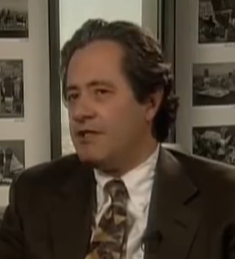
Francis Albert De Martini was an American architect employed by the Port Authority of New York, the agency that managed the World Trade Center, who died in the September 11 attacks in 2001.
Notes
Other ordinary citizens simply rose to the occasion. Brian Clark, a vice-president for a brokerage firm, heard someone call for help as he struggled down the stairway and found Stanley Praimnath trapped behind a pile of heavy debris.
Meanwhile, Brian Clark had just made it as far as the stairwell outside the 81st floor where he heard Stanley's cries for help. In spite of his vulnerability to dust and smoke because of his asthma and allergies, the broker entered that floor and went to work to free the man trapped in the rubble.
Brian Clark.
Further reading